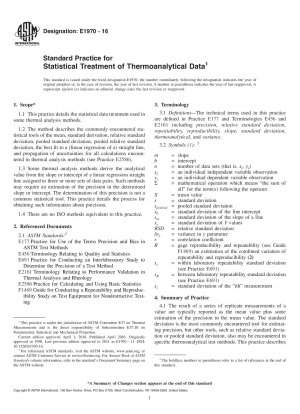ASTM E1970-16
Standard Practice for Statistical Treatment of Thermoanalytical Data
- Standard No.
- ASTM E1970-16
- Release Date
- 2016
- Published By
- American Society for Testing and Materials (ASTM)
- Status
- Replace By
- ASTM E1970-16(2021)
- Latest
- ASTM E1970-23
- Scope
5.1 The standard deviation, or one of its derivatives, such as relative standard deviation or pooled standard deviation, derived from this practice, provides an estimate of precision in a measured value. Such results are ordinarily expressed as the mean value ± the standard deviation, that is, X ± s.
5.2 If the measured values are, in the statistical sense, “normally” distributed about their mean, then the meaning of the standard deviation is that there is a 678201;% chance, that is 2 in 3, that a given value will lie within the range of ± one standard deviation of the mean value. Similarly, there is a 958201;% chance, that is 19 in 20, that a given value will lie within the range of ± two standard deviations of the mean. The two standard deviation range is sometimes used as a test for outlying measurements.
5.3 The calculation of precision in the slope and intercept of a line, derived from experimental data, commonly is required in the determination of kinetic parameters, vapor pressure or enthalpy of vaporization. This practice describes how to obtain these and other statistically derived values associated with measurements by thermal analysis.
1.1 This practice details the statistical data treatment used in some thermal analysis methods.
1.2 The method describes the commonly encountered statistical tools of the mean, standard derivation, relative standard deviation, pooled standard deviation, pooled relative standard deviation, the best fit to a (linear regression of a) straight line, and propagation of uncertainties for all calculations encountered in thermal analysis methods (see Practice E2586).
1.3 Some thermal analysis methods derive the analytical value from the slope or intercept of a linear regression straight line assigned to three or more sets of data pairs. Such methods may require an estimation of the precision in the determined slope or intercept. The determination of this precision is not a common statistical tool. This practice details the process for obtaining such information about precision.
1.4 There are no ISO methods equivalent to this practice.
ASTM E1970-16 Referenced Document
- ASTM E177 Standard Practice for Use of the Terms Precision and Bias in ASTM Test Methods
- ASTM E2161 Standard Terminology Relating to Performance Validation in Thermal Analysis and Rheology
- ASTM E2586 Standard Practice for Calculating and Using Basic Statistics
- ASTM E456 Standard Terminology for Relating to Quality and Statistics
- ASTM E691 Standard Practice for Conducting an Interlaboratory Study to Determine the Precision of a Test Method
- ASTM F1469 Standard Guide for Conducting a Repeatability and Reproducibility Study on Test Equipment for Nondestructive Testing
ASTM E1970-16 history
- 2023 ASTM E1970-23 Standard Practice for Statistical Treatment of Thermoanalytical Data
- 2021 ASTM E1970-16(2021) Standard Practice for Statistical Treatment of Thermoanalytical Data
- 2016 ASTM E1970-16 Standard Practice for Statistical Treatment of Thermoanalytical Data
- 2011 ASTM E1970-11 Standard Practice for Statistical Treatment of Thermoanalytical Data
- 2006 ASTM E1970-06 Standard Practice for Statistical Treatment of Thermoanalytical Data
- 2001 ASTM E1970-01 Standard Practice for Statistical Treatment of Thermoanalytical Data
- 2000 ASTM E1970-00 Standard Practice for Statistical Treatment of Thermoanalytical Data
